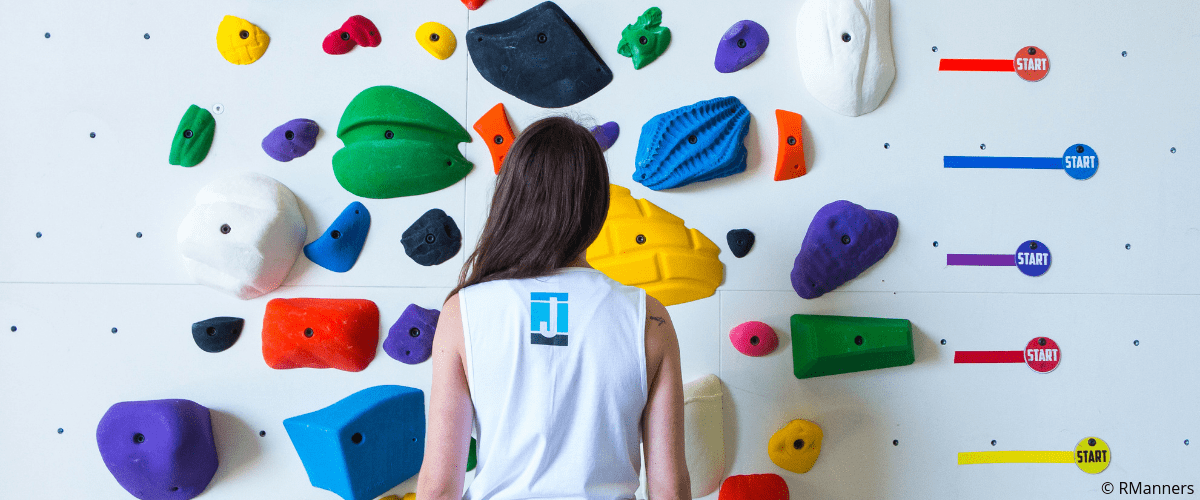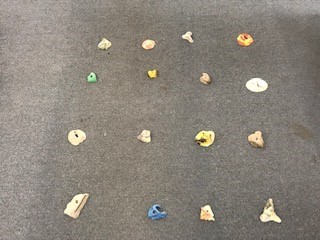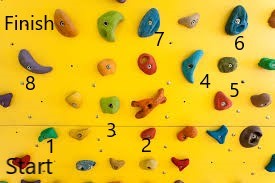Making Training Fun: Incorporating games to meet youth training goals

Meeting the learning objectives of beginner climbers in youth climbing programs can be a challenge. Varying ability levels and learning styles of youth climbers can make it difficult to structure programming in a way that keeps everyone engaged and allows them push their own abilities. To make matters worse, young climbers often come to us after their school day and are not ready for more instruction. That’s where group games come in.
Creative group games can be an effective way to engage young climbers and teach challenging concepts to groups of beginner climbers. Building games into the structure of youth climbing programming can also have the ancillary benefits of fostering a culture of fun and learning, helping with systems of group management, and allowing students to challenge themselves.
Using principles of experiential education and intentional facilitation, it is possible to take virtually any game, draw out targeted learning concepts, and guide climbers to learning goals all while creating an engaging, challenging, and fun experience for climbers.
Here’s how we, at Headwall Group, train climbing coaches to approach this process using one of our favorite examples.
In Preparation for Any Activity
Answer the following questions:
- What? What is our tool for teaching? Games work best when named because young climbers connect ideas to actions. When we name an activity, we give a reference point for our climbers. For example: “Remember the way we practiced footwork while playing the tag game? Use that same technique here.”
- Why? Why are we playing this game; what are the targeted concepts/skills?
- Who? What do we know about this group? What are the ages/skill level(s) of this group?
- Where? What equipment and space is necessary to play this game?
- How? What are the logistics for game play? Preparation is key; have a plan for setting up, explaining, and managing game play. Have a plan for debriefing. Prepare questions designed to pull out key concepts.
How to Facilitate the Game
Three components to facilitating for each game:
- Prepare
- Explain the objective and the rules. Be VERY clear about what is expected of climbers. Introduce the targeted skill. Check for their understanding.
- Game Play
- Signal the beginning of the game. Engage in the process with the climbers. Try to refrain from giving too much feedback/instruction during game play; allow climbers to try and fail/succeed on their own. Pay attention to specific things that can be recalled during the debrief.
- Debrief
- Avoid lecturing; use questions to draw out “ah ha!” moments from climbers. Start broad, narrow the questioning to lead the conversation to the targeted skill/purpose of the activity.
- Use specific examples of things that happened in the game to emphasize the point. For example: Johnny’s feet cut twice at the beginning of the traverse but by the end, his feet stayed on the wall for every move. What do you think Johnny changed about his approach to improve his footwork?
- End by drawing out how they will apply what they learned in the game to their approach to climbing.
This framework can be useful for coaches who may be very articulate about climbing concepts but struggle with application. It can also be very useful for coaches who are very skilled in the fundamentals of climbing but struggle with articulating these concepts to newer climbers. Further, this framework makes it possible to modify any game to meet a variety of different learning objectives. Below is an example of a game built out using this framework.
Example Game: Beta Map
Main Purpose: Introduce concept of planning, remembering, and executing beta
Skills Practiced: Concentration, footwork, balance, teamwork
Equipment Needed: 16 spot markers (loose climbing holds work well), open floor space, spray wall or traverse area
Part 1 Set Up: Create a 4x4 grid on the floor with the spot markers (use climbing holds if available), ideally in the same area as the climbing wall you will be using. Draw the grid and map a sequence from the starting hold to the finish hold; don’t let the climbers see the map.


The loose holds are arranged in a grid, only the coach knows the sequence from start to finish.
Part 1 Prepare:
- Explain that the team’s goal is to get everyone from the start hold to the finish hold, using a sequence the coach has pre-determined.
- The first climber will stand at the start hold and move to any hold that is adjacent to the start hold (front, side or diagonal) and the coach will say “yes” if this was the correct move in the sequence and “no” if it was not.
- If the climber chooses the correct move, they get to go again, if they do not, they go to the back of the line and the next climber starts from the beginning and attempts to remember the sequence that has already been revealed, and then guesses the next move.
- If they make an incorrect move or move to a hold out of sequence, their turn is over and they go to the back of the line.
- Continue until the entire sequence has been discovered and every climber is able to move through the entire sequence.
Part 1 Game Play:
- Specify what you want climbers to do when they are waiting their turn (stand in line, do push-ups, clap every time the active player makes a move. Be creative to keep them engaged).
- Give the team as much time as it takes to uncover the sequence.
- Try to notice strategies being used, things they are doing well, and things they could do better.
- Provide positive feedback but stay hands-off as much as possible.
Part 1 Debrief:
- Was it easy or difficult to remember every move in the sequence?
- What strategy did you use to remember the sequence?
- How did your teammates help you reach your goal?
- How do you think this relates to climbing?
- How will this become more challenging when on a climbing wall?
Part 2 Prepare:
- Explain that they will now attempt the same goal, but on the climbing wall this time.
- Encourage them to be thinking about their strategy as they play because they will be discussing it following the game.
 Part 2 Game Play:
Part 2 Game Play:
- Using the same rules, play the game on the climbing wall. Prepare the sequence ahead of time. The moves in the sequence should be attainable for all climbers in the group.
- Provide encouragement and make sure all climbers are staying engaged.
- When first playing the game, use open feet. To increase the difficulty, feet can be made “on” or “off in sequence.
- Focus on the targeted skill – don’t worry about coaching for footwork if the targeted concept is deciphering beta.
Part 2 Debrief:
- Was this easier or more difficult than playing the game on the ground?
- Was remembering the sequence difficult? What made it difficult?
- How can remembering beta help you when you are working on a route or boulder problem?
- How do you support your teammates when they are having a hard time figuring out the beta on a climb?
By using the Prepare → Game Play → Debrief structure and applying games to a climbing practice, coaches can engage a large group in the process of learning targeted skills, while being certain young climbers are having fun.
Do you have creative games that you use to teach skills? We would love to hear them. Leave your ideas and feedback in the comments section below. You can also reach out to us directly at info@headwallgroup.com.
About The Author
 The Headwall Group distills the lessons learned as educators and leaders working in dynamic and high risk environments and brings them to youth-serving organizations. The Headwall group provides trainings, consultation, and curriculum development services that are rooted in our experience as outdoor experiential educators for climbing gyms, summer camps, and schools.
The Headwall Group distills the lessons learned as educators and leaders working in dynamic and high risk environments and brings them to youth-serving organizations. The Headwall group provides trainings, consultation, and curriculum development services that are rooted in our experience as outdoor experiential educators for climbing gyms, summer camps, and schools.
The Headwall Group was founded by Bix Firer and Pat Brehm. Bix Firer (MA, University of Chicago) is currently the Director of Outdoor Programs at College of Idaho and has worked as a wilderness educator, trainer, facilitator, and experiential educator for over a decade. Pat Brehm works as a professional organizational trainer and has spent his career as a climbing coach, facilitator, and outdoor educator.
